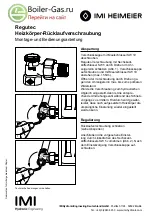
25
INSTALLER SETTINGS
The tasks in this section must only be carried out by qualified personnel.
Carrying out these procedures wrongly may damage the control unit and boiler or cause them to malfunction.
●
CONNECTING UP TO THE OUTDOOR TEMPERATURE SENSOR.
The control unit can also be fitted with a sensor that monitors outdoor temperature.
The outdoor temperature reading utilised by the control unit may be supplied in one of two different ways:
-
when the outdoor temperature sensor is connected to the boiler the temperature reading is sent from
the boiler to the control unit.
-
when the outdoor temperature sensor is connected directly to the control unit the reading is acquired
and processed by the control unit directly.
If both are present the local sensor is ignored and the outdoor sensor connected to the boiler base is
utilised.
This situation is highlighted by the appearance of error message
E67
.
To connect the outdoor sensor to the control unit use the S.EXT connection on the terminal block.
With the outdoor sensor connected, pressing the
key shows the outdoor temperature and heating
water temperature.
●
ENABLING REMOTE OPERATION
The control unit has an input (
TEL
+
and
-
) which allows connection of an optional control unit for distance
operation.
Operating mode:
-
TEL
input open
The control unit operates as described in the handbook.
-
TEL
input closed
The control unit switches to remote mode, that is:
heating and hot water functions enabled, automatic temperature regulation according to timer programme
with on-display information while upper display shows the
TEL
message in place of room temperature.
This mode persists until the user disables it by acting on the remote mode switch (
TEL
input open). Standard
operating mode is then restored.
●
CLOCK SPEED CORRECTION
Allows you to improve clock precision by increasing speed (should it run slow) or decreasing speed
(should it run fast).
The entire correction procedure must be done with the control unit powered and connected to the boiler.
Clock correction:
Press key
R
and keep it pressed.
Press the
H/Day
key
Release the
R
key and wait for the display to show the “
Hour
” confirmation message.
The next two stages must be done within 5 seconds otherwise the procedure will be aborted (a change of
one unit alters clock speed by 30 seconds a year).
Release the
H/day
key.
Press the
+
key to increase clock speed (an increase of one unit speeds up the clock by 30 seconds a year).
Press the
–
key to reduce clock speed (a decrease of one unit slows down the clock by 30 seconds a year).
Wait 5 seconds after the last modification to exit this function and recommence normal operation.
32
PROGRAMACIÓN DE LA HORA Y DEL DÍA DE LA SEMANA
Se puede programar la hora y el día de la semana en todos los modos de funcionamiento.
Para activar la programación presione una vez el botón
H/Day
.
En la pantalla empezarán a parpadear las cifras correspondientes a los minutos.
Presione los botones
+
y
–
para establecer los minutos y luego presione de nuevo el botón
H/Day
para confirmar.
En la pantalla empezarán a parpadear las cifras correspondientes a las horas.
Presione los botones
+
y
–
para establecer la hora y luego presione de nuevo el botón
H/Day
para confirmar.
Una vez finalizada la programación de la hora, empezará a parpadear el indicador del día
.
Los indicadores
indican de forma secuencial el día de la semana de lunes a domingo (1 = lunes, 2 =
martes, etc.).
Presione los botones
+
y
–
para establecer el día deseado y luego presione el botón
P
para memorizar todas
las programaciones.
SELECCIÓN DE LAS FUNCIONES
El termostato programador gobierna el funcionamiento de la caldera activando o desactivando, de acuerdo
a las exigencias, cada función en particular.
Presionando varias veces el botón
, se activan en secuencia las funciones “OFF” – “circ. sanitario” – “circ.
sanitario/calefacción” – “calefacción”.
●
FUNCIÓN “OFF” (PALABRA “OFF” EN LA PANTALLA)
Esta función permite desactivar las funciones “circ. sanitario” y “calefacción” manteniendo activas sola-
mente las funciones de seguridad vinculadas a la caldera.
En este caso se ignoran la demanda de agua caliente sanitaria y la demanda de activación correspondiente
al circuito de calefacción.
●
FUNCIÓN “CIRC. SANITARIO” (SÍMBOLO
ENCENDIDO)
La función activa el funcionamiento de la caldera para la producción de agua caliente sanitaria.
Con esta función activada se puede regular la temperatura del agua sanitaria deseada.
En este caso se ignora la demanda de activación correspondiente al circuito de calefacción.
●
FUNCIÓN “CIRC. SANITARIO/CALEFACCIÓN” (SÍMBOLOS
Y
ENCENDIDOS)
La función asocia las funciones “circ. sanitario” y “calefacción”, activadas automáticamente de acuerdo
a la demanda.
●
FUNCIÓN “CALEFACCIÓN” (SÍMBOLO
ENCENDIDO)
La función activa el funcionamiento de la caldera para la activación del circuito de calefacción en
“automático” o “manual”.
Con esta función activada se puede regular la temperatura del agua de calefacción y programar la hora
deseada para el funcionamiento en “automático”.
En este caso se ignora la demanda de producción de agua caliente sanitaria.
Содержание thin 24 MCS W TOP U/IT
Страница 3: ......
Страница 5: ......
Страница 7: ......
Страница 9: ......
Страница 11: ......
Страница 13: ......
Страница 15: ......
Страница 17: ......
Страница 19: ......
Страница 21: ......
Страница 23: ......
Страница 25: ......
Страница 27: ......
Страница 29: ......
Страница 31: ......
Страница 33: ......
Страница 35: ......
Страница 37: ......
Страница 39: ......
Страница 41: ......
Страница 43: ......
Страница 45: ......
Страница 47: ......




































